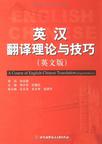英汉翻译理论与技巧
出版时间:2009-1 出版社:北京航空航天大学 作者:李庆学//彭建武 页数:176
前言
在国际上,现代翻译学究竟产生于什么时间,还没有定论。比较典型的说法有如下几种:1.谭载喜在1995年第3期《外国语》上发表的“中西现代翻译学概评”一文中谈到,据德国翻译理论家维尔斯所说,现代翻译学的起源,可追溯到(20世纪)40年代美国翻译理论家奈达发表的《论圣经翻译的原则和程序》。奈达在这部著作中,运用现代语言学手段,首次较为系统地对翻译的过程加以阐述,后又明确提出翻译是科学的主张,因此被西方学者尊为现代翻译科学的开山鼻祖;2.以“翻译学”或“翻译科学”二词的首次使用为标志,一种说法是,“以J.霍姆斯首先使用‘翻译学’一词算起,则翻译学始于70年代初”①,另一说认为,“英语的translatology是1971年Roger Coffin在Meta上用法语发表的文章中提出的,之后大家就用了这个词。”②3.“如果以它在西方高等院校成为一门独立的学科,或以美国‘当代语言学会’(MLA)把它列为单独的研究领域为依据,则翻译学始于80年代初。”③笔者赞成以translatology一词的出现为标志,即现代翻译学创始于(20世纪)70年代初。
内容概要
本书可供英语语言文学、翻译等专业本科生使用,还适合非英语专业大学生、研究生以及广大翻译爱好者选择使用。本教材在编写中坚持科学性、学术性、实用性相统一的原则,力求将理论探讨与技能培训融为有机的整体,使学习者通过本书可以既具备一定的理论知识基础,又具备较强的翻译实践能力。翻译理论一向是本科阶段翻译教学的薄弱环节,本书编写的一个重要初衷就是弥补这一薄弱环节,使学习者既掌握一定的理论知识和理论表述方式,又能自觉地应用这些理论来指导自己的翻译实践,避免翻译过程中的盲目性和随意性。同时本书也可以为学习者日后进一步深造,更为深入系统地研究翻译打下一定的基础。本书的一大特色即是理论与实践并重。在理论方面,本书涉及翻译标准、翻译单位、翻译过程、翻译与文化等翻译研究的基本论题;在实践方面,本书除在理论部分融入大量翻译例证和个案研究外,还在每一章的后面都辅以精心设计的翻译练习,帮助学习者提高翻译能力。
书籍目录
Chapter 1 Introduction to Translation 1.1 About Translation 1.1.1 Translation as an Industry 1.1.2 Translation as a Profession 1.1.3 Translation as a Major 1.1.4 Translation as a Course 1.2 Nature and Definition of Translation 1.2.1 Difficulty in Defining Translation 1.2.2 Nature of Translation 1.2.3 Definition of Translation 1.3 Translators’ Competence 1.3.1 A Sense of Responsibility 1.3.2 Bilingual Competence 1.3.3 Bicultural Competence 1.3.4 Encyclopedic Knowledge ExercisesChapter 2 A Brief History of Translation 2.1 About Translation History 2.2 A Chinese History of Translation 2.2.1 Three Climaxes of Translation in China 2.2.2 Translation from 1949 to the Present 2.3 A Western History of Translation 2.3.1 An Overview of Western Translation 2.3.2 Six Climaxes of Western Translation ExercisesChapter 3 Translation Criteria 3.1 Translation Criteria of China 3.1.1 Early Criteria 3.1.2 Present Criteria 3.2 Translation Criteria of Western Scholars ExercisesChapter 4 The Process of Translation 4.1 Description of Translation Process 4.2 The Fourphase Process in Translating 4.3 The Basic Process of Translation 4.3.1 Accurate Comprehension 4.3.2 Adequate Representation 4.3.3 Revision ExercisesChapter 5 Contrastive Studies of English and Chinese 5.1 Contrastive Analysis of the Words and Phrases 5.2 Contrastive Analysis of the Sentences 5.2.1 General Description 5.2.2 Syntactic Differences between English and Chinese 5.3 Contrastive Analysis of the Texts 5.3.1 Maintenance of the Original Coherent Structure 5.3.2 Modification of the Original Coherent Structure 5.3.3 Modulation of the Original Thematic Structure ExercisesChapter 6 Culture and Translation Chapter 7 The Unit of TranslationChapter 8 Translation of WordsChapter 9 Translation of SentencesChapter 10 Translation of English for Science and Technology Chapter 11 Translation of Legal Documentation Chapter 12 Translation of Trademarks Chapter 13 Translation of News ReportsKeys to Translation Exercises
章节摘录
Nowadays, translation is not only an academic and intellectual activity of scholars but also a commercialized industry. The form of translation has been diversified and translation activity has been closely integrated with many other walks of life because of rapid economic and social development. With Chinas entry into the WTO, a new peak of translation has already occurred. Translation has been increasingly industrialized and commercialized around the world. According to the survey conducted by ABI (Allied Business Intelligence Inc.), there are 14 thousand professional translators and 25.2 thousand part-time translators. A great number of multinational translation companies such as Lemout & Hauspie (L&H) in Belgium, Interverbum in Sweden and Star in Germany have been created.
图书封面
评论、评分、阅读与下载
